Mary Robinette Kowal's Blog, page 6
October 17, 2024
My Favorite Bit: Curtis C. Chen talks about TRUE BLUE KANGAROO

Curtis C. Chen is joining us today to talk about his novel, True Blue Kangaroo. Here’s the publisher’s description:
Kangaroo doesn’t want to go to prison?
Too bad, Kangaroo!
Be seeing you.
Welcome to the future, where humanity travels between planets with ease and has abused that power to establish outposts in the most unlikely places.
Take Venus, for example: a sister world to Mother Earth, similar in size and gravity, it’s also known for having a toxic atmosphere and hellish landscape at ground level. But climate-controlled habitat domes stay in eternal sunlight and offer vacationers endless good times while floating through blue skies above the clouds of deadly acid.
Meanwhile, hidden down inside those poisonous clouds are other floating habitats, so-called “blue sites”—government-run secret prisons where inmates are incarcerated with no oversight and no hope of escape.
And why, pray tell, would secret agent Kangaroo, with his pocket superpower and agency-issued biotech implants, need to infiltrate such a secure facility? Might it be to rescue another spy who’s gone radio silent? Or perhaps to extract a high value asset who claims to have been wrongly imprisoned therein? Possibly both?
It’s six of one, half a dozen of the other. Questions are a burden to others, and answers a prison for oneself.
What do you want? Information? That would be telling.
Set in the same world as WAYPOINT KANGAROO and KANGAROO TOO, this high-octane science-fiction spy thriller, teeming with adrenaline and intrigue, continues spinning blockbuster outer space adventure.
What’s Curtis’ favorite bit?
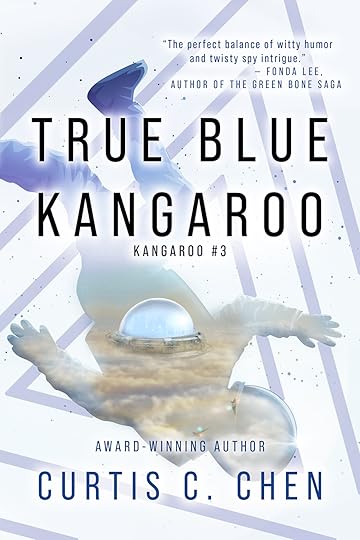
My third Kangaroo novel features a wacky futuristic lockup inspired by the cult-classic 1967 Patrick McGoohan television series “The Prisoner.” Wait, come back! I promise this is actually interesting!
Okay, fine, you’ve never heard of “The Prisoner.” (To be clear, I am not talking about AMC’s bogus 2009 remake, which you also haven’t heard of, and I’m definitely not talking about Denis Villeneuve’s hyper-mega-bummer 2013 film Prisoners with Hugh Jackman and Jake Gyllenhaal–LOOK APPARENTLY “PRISONER” IS A POPULAR WORD IN SHOW TITLES FOR SOME REASON, MOVING ON.)
Trust me, “The Prisoner” is your favorite TV showrunner’s favorite TV show. It has influenced everything from “Lost” to “Babylon 5” to “The Simpsons.” My personal fascination with this short-lived phenomenon (it ran for only seventeen episodes in the UK) extends back to the 1980s, when teenage Curtis was watching a lot of Britcoms on our local PBS station late at night. You know: “Monty Python’s Flying Circus,” “Red Dwarf,” “Are You Being Served?”, all the classics. So I was aware of “The Prisoner” and immediately became fascinated with its whole “science fiction spy mystery” vibe (sound familiar?), but it never actually aired on my affiliate.
In 1988, I got my hands on a copy of the then-new paperback The Official Prisoner Companion by Matthew White and Jaffer Ali. To this day, I remember poring over that text more vividly than I remember actually, finally watching the show in later years. (Side note: I also read the authorized sequel comic, Shattered Visage, before ever viewing the original series.) And just as watching a TV show made in the 1980s does not tell you what the 1980s was actually like to live through, reading about a TV series is very much not the same as the experience of watching the show itself.
All of this inspired the backstory that informs a big part of my main character Kangaroo’s personality:
he was orphaned at a young age;his only connection to his dead parents was their archive of twentieth-century entertainment media that they had studied as academics;so young Kangaroo watched a lot of old movies and TV while growing up; andthat leads to him now constantly making outdated jokes and references that are meaningless to his colleagues.Comedy gold! You’re welcome.
So why, you may ask, was “The Prisoner” so great anyway? Well, this is awkward…
It’s a deeply #IYKYK situation, which I acknowledge is also an extremely meta reference, but that’s honestly the best way I can describe it. This isn’t even some Matrix-type “You have to see it for yourself” tomfoolery, because after you see it, you’ll have even more questions. Why are they all dressed like that? What’s up with the numbers instead of names? And what is the deal with that freaky weather balloon thing?
All of this weirdness made “The Prisoner” (yes I am always going to put the title in quotation marks, DEAL WITH IT) the perfect inspiration for Cerulean City, the secret “blue site” on Venus where Kangaroo needs to go undercover as a (…wait for it…) prisoner. But am I going to get sued by ITC for all the blatant, not even mildly disguised references? Like just straight-up lifting turns of phrase like “be seeing you” and “that would be telling” and “why did you resign” and many more?
As they say in the Village: questions are a burden to others, and answers a prison for oneself. (That’s literally in the back cover copy for my book. COME AT ME BRUV)
LINKS:
BIO:
Once a Silicon Valley software engineer, Curtis C. Chen (陳致宇) now writes stories near Portland, Oregon. His debut novel Waypoint Kangaroo (a Locus Awards and Endeavour Award Finalist) is the first in a series of funny science fiction spy thrillers, followed by Kangaroo Too (which received a starred review from Publishers Weekly) and True Blue Kangaroo, with a fourth book coming soon. He has written for the Realm original podcasts Echo Park, Ninth Step Murders, and Machina.
Curtis’ shorter works have appeared in Playboy Magazine; the ENNIE Award-winning Kobold Guide to Roleplaying; The Year’s Best Fantasy, Volume 2; Aliens vs. Predators: Ultimate Prey; and elsewhere. His homebrew cat feeding robot was displayed in the “Worlds Beyond Here” exhibit at Seattle’s Wing Luke Museum. He is a graduate of the Clarion West and Viable Paradise writers’ workshops.
Curtis is not an aardvark.
October 15, 2024
My Favorite Bit: Alex Kingsley talks about EMPRESS OF DUST

Alex Kingsley is joining us today to talk about their novel, Empress of Dust. Here’s the publisher’s description:
Harvard is small, anxious, and plagued by a constant tremor, which is not an ideal combination for a desert scavenger. He and his crew are under constant threat of desertwalker attacks, and Harvard is nearly useless against them.
When the biggest mistake of Harvard’s life separates him from his crew, he must learn the secrets of the desert beasts in order to survive the dangers of the dusts. Returning to Bastion with a surprising ally, Harvard is forced to choose between saving his crew or allying with the “monsters” who rescued him.
Harvard never saw himself as a hero, but when the beasts of the dusts implore him to aid their rescue mission, he holds the lives of crabs and humans alike in his trembling hands.
What’s Alex’s favorite bit?
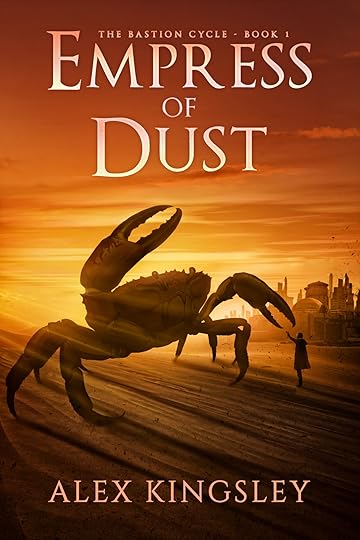
My favorite bit of Empress of Dust is the scene that I refer to in my notes as the BDM — Big Damn Moment. I like it because it combines all the things that made writing this book so fun: it’s illuminating of character, it’s sweet, it’s funny, and it involves crabs (most of the novel involves crabs, but there is the occasional crabless moment).
For context, this is a story about a future where most species have evolved into some form of crab. I allowed myself to have a lot of fun imagining these carcine hybrid creatures, and I really hope I don’t send any evolutionary biologists into a frenzy because I sometimes get a little silly. My crabs and not like other girls (or, rather, other crabs). They have telepathy and magic blood and such.
At this point in the story, the main character, Harvard has been captured by the titular Empress and her guardian, Skrack, who require a service from him. But when the Empress’s scouts report his crew is in danger, Harvard draws the line — he won’t continue to help the Empress unless she lets him try to save his friends.
One of the reasons that I love Harvard is that he is not very brave. He’s not particularly strong or smart or anything that he wishes he was. So it’s a really big deal for him to make a stand. Above all else, Harvard cares, and I think this scene is where we see that care most prominently. He may not be able to stand up for himself, but goodman it, he will stand up for his friends.
And then he gets mobbed by tiny crabs because they love him and don’t want him to leave.
This leads me to my other favorite part about this moment, which and the way that the Empress and Skrack respond. Skrack was pretty clear about the fact that the consequences for Harvard’s rebellion will be that he gets eaten by the hatchlings, but the hatchlings don’t seem too interested in doing that. According to the Empress, this is because the hatchlings have grown fond of him, and according to Skrack this is because his flesh disgusts them.
Skrack just makes me laugh. I have enjoyed writing him so much. I love a cynical giant crab who can’t admit that maybe possibly his children have come to like a human of all things.
The last thing I really love about the scene is the way I picture it in my head. Harvard doesn’t make it two seconds before the crabs bring him down, and then he’s just trapped under a mass of tiny crabs because they love him and want to shower him with tiny gifts.
On a process level, I have a lot of affection for this scene, because it is an example of the way that my beloved writers group has helped me develop this story. I am part of a group informally titled the Silent Notetakers Writers’ Collective (so named because we often say to each other, “I’m listening, I promise, I’m just being quiet because I’m taking notes”) and their input has been crucial to my development as a writer. The members of SNWC were the first people to read the first chapter of this novel, back when it looked entirely different and I had no idea where it was going. They’ve been so important to shaping not only this story, but the way I approach storytelling on the whole. It was one of those members who dubbed this scene a Big Damn Moment, and that’s how I started referring to it in my notes. It was originally a less significant scene, but my writers group convinced me that if I made it more dramatic, it could be a pivotal character moment for Harvard. I’m very happy with how the scene turned out, and very thankful to everyone who helped me get the story to its finished form.
I’m so thrilled for people to be able to read this scene (and also the rest of them) so soon when the book is out!
LINKS:
Website | Instagram | Bluesky | Mastodon | Tiktok
BIO:
Alex Kingsley (they/them) is a writer, comedian, game designer, and playwright. They are a co-founder of the new media company Strong Branch Productions, where they write and direct sci-fi comedy podcast The Stench of Adventure and other shows. Their debut novel Empress of Dust will be published by Space Wizard Science Fantasy in Fall 2024. Their short fiction has appeared in Translunar Travelers Lounge, Radon Journal, The Storage Papers, and more. In 2023 they published their short story collection, The Strange Garden and Other Weird Tales. Alex’s sci-fi plays have been produced in LA, Philadelphia, and Chicago. Alex’s SFF-related non-fiction has appeared in Interstellar Flight Magazine and Ancillary Review of Books. Their games can be downloaded pay-what-you-will at alexyquest.itch.io.
October 10, 2024
My Favorite Bit: Jelena Dunato talks about GHOST APPARENT

Jelena Dunato is joining us today to talk about her novel, Ghost Apparent. Here’s the publisher’s description:
Betrayed, deposed and presumed dead.
When her father is killed in a bloody coup and her uncle seizes the city, Orsiana pleads for help with the only power still willing to listen, unaware that the gods will use her as a pawn in their own game.
Thrown back on the streets of Abia, armed with the gods’ double-edged gifts, Orsiana must thwart her uncle’s plans and learn what it takes to rule a proud, stubborn city that thrives on artifice and wit. She will plot, fight and use lethally tuned verse to stir a rebellion. But just when her uncle’s Machiavellian schemes start to topple, a new player will enter the game, and the gods will raise the stakes. It’s easy to fight an enemy you hate, but how about an enemy you fall in love with? If she wants to win, Orsiana will have to risk the last precious thing in her possession: her heart.
A story of revenge and recovery, Ghost Apparent blends the history and folklore of the Eastern Adriatic with the bloody treachery of the Renaissance courts and is a perfect read for the fans of dark political fantasy.
What’s Jelena’s favorite bit?
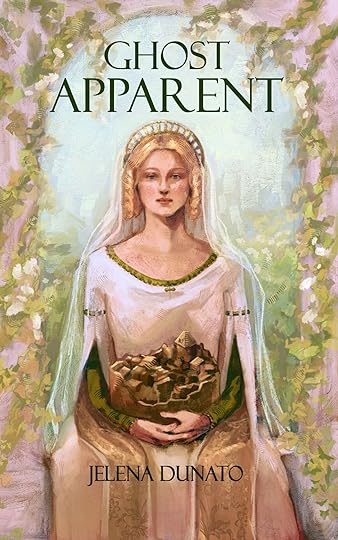
Watching Dubrovnik from its magnificent walls last winter, admiring the red roofs and white stones basking in the sunshine, the incomparable quality of the clear, golden light that seduced painters and poets alike, it occurred to me that, if this image was all that people knew of Croatia, it would probably be enough.
Unfortunately, the publishing industry doesn’t work with tourist boards and my books often get bunked with much larger cultures under the label of “Slavic fantasy”. Imprecise and vague, this signals that the book probably contains bits of Polish or Russian folklore, snowy landscapes, tiny wooden houses infested with household spirits and maybe even a guest appearance by Baba Yaga. No sunlit coastal towns, no olive groves, no brilliant blue waves – no trace of my heritage. And yet, I am just as Slavic as any Polish or Russian person, but I am also Mediterranean, living on the coast where dozens of cultures and peoples mixed over the centuries. In order to be true to my heritage, I’ve decided to build a Slavic world inspired by the Eastern Adriatic.
Ghost Apparent, my upcoming novella, is a short work with some big world building. This doesn’t mean it’s bogged down by extensive descriptions or info dumps: the story moves fast, but it moves through a multi-layered setting, an intricate tapestry of history, art, culture and folklore which extends beyond the borders of this little novella.
Let me introduce you to Abia, a town which I wrote as a love letter to all the ancient, beautiful, proud walled towns of the Adriatic coast, and their complex and turbulent history. It is built of sunlight and stone, mixing the medieval architecture – Romanesque and Gothic – with the early Renaissance.
Perhaps I should let one of my characters describe it:
“You’ll love its narrow streets, teeming docks, colourful sails and ancient palaces. It’s more alive than any town I’ve seen, bristling with pride and insolence. It doesn’t reveal its beauty easily, but there are autumn afternoons when the light is soft and golden, and the walled gardens smell of oranges and jasmine. There are shadowy squares with fountains, where young men fence out of boredom, houses with heavy wooden shutters and light curtains lifted by the summer wind, there’s salt in the air, and the constant, faraway sound of the waves.”
Who rules such a town? A clever ruler with a light touch, who understands the illusion of self-ruling. Orsiana, my heroine, survives a bloody coup and escapes with nothing but her life. To reclaim power, she must first understand what power means in a free medieval commune with its own Council, its ruling patrician class and its version of democracy. I wanted to create a system of government which cannot be easily taken over by brute force nor inherited automatically, where the ruler who can’t feel the pulse of the city loses their position quickly. Too often is medieval fantasy filled with conquerors and absolute feudal rulers – I wanted Machiavellian intricacy, a fine balance of power.
And yet, my aim wasn’t to write a purely historical novella. Behind the layers of history and politics beats a dark fantasy heart, filled with Croatian folklore, and a bunch of capricious gods, flawed, dangerous and powerful. There’s Korab, the God of the Sea and his sea maidens; Veles the Trickster and his riddles; Lada, the Goddess of Love and her fountain of youth and Morana, the Goddess of Death. And like in every good fairy tale, where every fulfilled wish is also a curse, my heroine has to learn how to handle their double-edged gifts as she fights for her life, her birthright and her heart.
“Ghost Apparent” is a dark fantasy novella inspired by my heritage. If my world building, with all the elements of art, history and folklore I’ve mentioned, manages to shake the “Slavic” label and move the focus towards the SE Slavic cultures, I will consider it a success.
LINKS:
BIO:
Jelena Dunato is an art historian, curator, speculative fiction writer and lover of all things ancient. She grew up in Croatia on a steady diet of adventure novels and then wandered the world for a decade, building a career in the arts.
Jelena’s stories have been published in Beneath Ceaseless Skies, The Dark, Future SF and Mermaids Monthly, among others. She is a member of SFWA and Codex. Her novel, Dark Woods, Deep Water, was published in September 2023. Her new novella, Ghost Apparent, is coming out in September 2024.
Jelena lives on an island in the Adriatic with her husband, daughter and cat.
October 8, 2024
October 2024 Update: News, Events, and More
Note: If you’d prefer to receive this monthly update in your email inbox (along with additional content, like my cat’s latest conversations), you can sign up for my newsletter here.
This newsletter is a bit delayed this month, because I’ve just returned from the annual Writing Excuses Cruise. I always look forward to this event, though it takes my full attention. It gives me an opportunity to connect with writers, teach classes, and provide critique, all while on board a luxurious cruise ship.
This year was no exception. Once again, I’m deeply grateful for the community that has sprung up around the podcast. If you want to join me for next year’s cruise, head here and sign up for more information.
With the cruise behind me, I’m now gearing up for the Surrey International Writers’ Conference—one of the highlights of my year. If you get the chance to attend, either in-person or virtual, I highly recommend it.
Outside of conferences, my mind is on the upcoming release of The Martian Contingency. There’s a lot in the works, and I’m excited to share it with you once I’m able.
A quick snapshot of what I’m…
Crafting: Nora Forest Meadow sweater in a plum silk cashmereReading: The Bright Sword by Lev GrossmanWriting: “The music was waves crashing against a cliff. My violin was a single rivulet of that cascade, but I followed the same flowing path down the rocks. I chased the line through the darkness and back to the sea.”Watching: Death and Other Details – Manny Patinkin! Murder! Cruise ship!Enjoying: Blackhound Tavern candleNOTEWORTHY NEWSUpcoming Workshop: The Progression of a Character ArcIn this deep dive on character arcs, you’ll take a look at how you can have your character change in a believable way. Many writers think a character needs to be deeply flawed at the beginning in order to have an arc—but this isn’t always the case.
This class will look at how to pry into the cracks in your character’s personality to create conflict and tension.
Join the Class!Book Club UpdateThank you so much for filling out last month’s questionnaire around a Lady Astronaut book club! The results were largely positive, and you all gave me some really wonderful ideas. I’m currently working with my team to put together an action plan.
Keep an eye on your inbox for more information as I finalize the next steps.
In the meantime, you can prepare yourself by pre-ordering The Martian Contingency.
Each month, I’ll post a new link to a book, short story, or other work I think deserves a read. Sometimes it will be my own writing, other times it will be someone else’s.
This month, I’m highlighting O Little Town of Bethlehem, by Elizabeth Boyle. It’s such a cozy book—exactly the sort of thing you want to read while curling up with a cup of cocoa. Think of Brigadoon, but with a modern woman falling through into a town that offers second chances to people who are willing to take them. Taking that chance though, is hard. It’s so lovely.
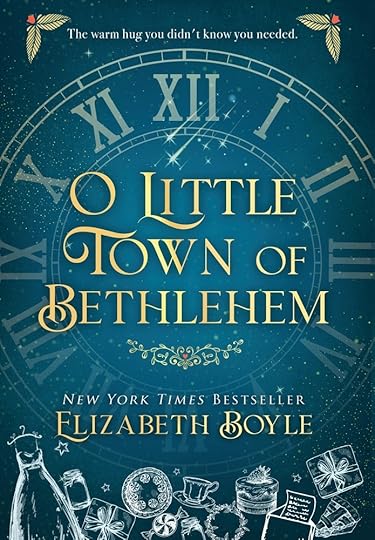
O Little Town of Bethlehem
Everyone deserves a second chance, even Madeline Drake.
When a snowy accident topples Madeline through a slip in time, she wakes to find herself in tiny, turn of the century, Bethlehem, Wyoming. Her arrival sends a ripple of change through the tenaciously rooted lives of the town’s odd collection of lost souls, who view her arrival with a healthy dose of skepticism and curiosity.
Parathinia Minch is known as the most honest woman in Bethlehem, until faced with a truth that could tear apart the fabric of her beloved community. In a fateful second, she does something she’s never done before: she lies. All too quickly, Ninny’s decision unspools an unruly tangle of problems that threaten her reputation and her livelihood.
Savannah Clarke has been lost in a tide of grief and pain since she was unwillingly towed through time and deposited in Bethlehem. She’s spent decades scoffing at the town’s exuberance for the holidays, building a wall around herself to avoid their merry cheer. But Madeline’s arrival brings a bright light to the small town and has Savannah questioning the time she’s lost and the possibility of a shiny new future.
And Madeline? The catalyst of all this turmoil? She’ll do anything to return to her own time. Yet Bethlehem, with its currency of wishes and second chances, offers her a place she never expected to find. . . but only if she’s willing to give up everything she holds dear.
Get Your CopyFEATURED PATREON EVENTMake Me Write: Sundays 10 AM Eastern TimeWriting is often thought of as a solitary task. Unfortunately, motivating yourself to write consistently, without the support of others, can be daunting.
The truth is, many people’s brains don’t work well in isolation. Coworking, collaborating, and cheering one another on lead to far more words on the page than writing in isolation.
Make Me Write is a Patreon tier dedicated to those of us who benefit from the presence of others to create consistency. It’s a weekly writing date with (optional) prompts, reflection, and, of course, writing time.
Join the Make Me Write Tier of Patreon
WHERE TO FIND MARY ROBINETTEHere’s where you can find me in the coming months:
New York Comic Con (October 17 – 20, New York City)Surrey International Writers Conference (October 25 – 27, Surrey, BC)Nantes Utopiales (October 31 – November 3, Nantes, France)Sandia Starforgers Writers Retreat and Workshop (May 2 – 5, Albuquerque, NM)ELSIE‘S CORNER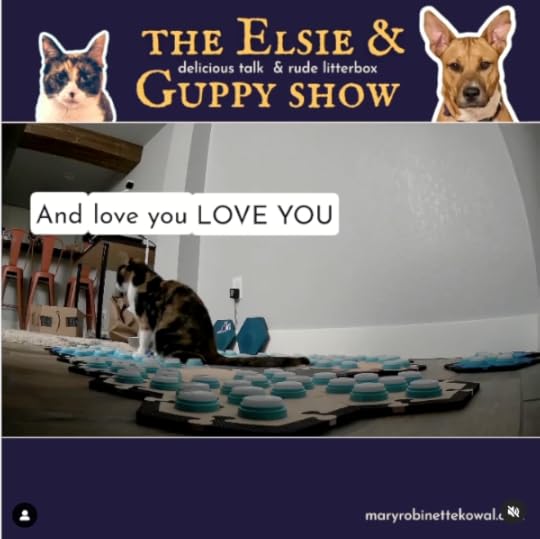
This time of year, I travel a lot.
Unfortunately, that means Elsie is trapped with the spare human (my husband).
She doesn’t always appreciate this arrangement, especially when she isn’t getting the same amount of attention.
But at least she fully understands how to ask for what she needs.
Don’t worry, the spare human was happy to oblige.
See for yourself.
If you’d prefer to receive this update in your email inbox (along with additional content, like my cat’s latest conversations), you can sign up for my newsletter using the form below. I’ll also send you a short story in thanks.
My Favorite Bit: Lauren C. Teffeau talks about A HUNGER WITH NO NAME

Lauren C. Teffeau is joining us today to talk about her novel, A Hunger with No Name. Here’s the publisher’s description:
Thurava of Astrava is intended to become a herder, a most honored position for her dwindling community that clings to life on the banks of the Najimov, the river that’s the lifeblood of the high desert. But the Glass City on the horizon threatens the delicate balance the Astravans have managed to hold on to for centuries, polluting the air and water as the city grows bigger and bigger. The Glass City’s clockwork liaisons offer to bring the Astravans into the Glass City’s walls, but they will have to give up their ways and their precious herds to do so. Thurava must decide who she is without her animals, using the stars as her guide, putting herself on a collision course with the secrets the Glass City holds dear.
What’s Lauren’s favorite bit?
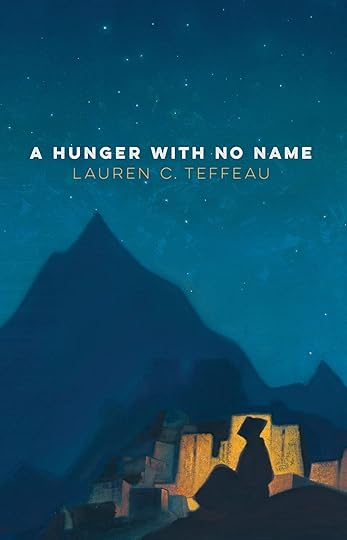
Whenever I write a story, I give myself what I’ve taken to calling a technical challenge to tackle over the course of the narrative. Not only am I trying to write a complete story with compelling characters and a unique plot, but I’m also trying to include a secret third thing to push me to develop my craft even if the story remains unpublished and relegated to the annals of my hard drive.
Sometimes that means writing to a tight deadline to prove I’ll be able to do so again when I’m under contract. Sometimes that means writing a story about trauma or grief or mass comm theories or whatever my current obsession is without ever explicitly saying so in the text. And sometimes, as is the case in my latest book A Hunger with No Name, which was last week, it means creating an entire worldview from scratch. One that not only worked for the story I was trying to tell, but was also not rooted in any sort of higher power, god/dess, or deity. In other words, I wanted to explore what a cultural mythos looked like without a theistic default. And the result has become my favorite bit of writing the novella.
A Hunger with No Name explores how the fate of a young herder named Thurava from a low-tech culture intersects with a much higher-tech one found in the Glass City lurking on the horizon, blowing up her worldview in the process and putting her values to the test as she comes face-to-face with technologies from the age before that should have been lost to time. Technologies that threaten the very existence of her culture because too many of her people view them as magic—too strong, too compelling, to fight off any longer.
But it felt too easy—too reductive—to have Thurava’s people believe in some kind of god to signal their relative lack of sophistication compared to the people living within the city walls. So instead I created a series of stories set in the stars, distilling their history down into lessons associated with constellations in the sky, a winnowing process that mirrored the winnowing of their society over the years. Each story features archetypes that encapsulate their culture’s values. Think Aesop’s Fables mashed up with variations on the monomyth. Not only do these constellation stories guide Thurava’s journey, they also help structure the novella, where each chapter is named after some aspect of those stories.
The resulting mythic texture (and thematic resonance, of which I’m particularly proud) gives A Hunger with No Name the feel of second-world fantasy even though there is no magic and much of the technology she encounters is rooted in what is possible today. I hope you will join me in charting your own journey through the stars that feature so prominently in the book.
LINKS:
BIO:
Lauren C. Teffeau is a speculative fiction writer based in New Mexico. Her novel Implanted (2018, Angry Robot) was shortlisted for the 2019 Compton Crook award for best first SF/F/H novel and named a definitive work of climate fiction by Grist. Her latest novella, the environmental fantasy A Hunger with No Name, was released on September 20, 2024 by the University of Tampa Press and is available wherever books are sold. She’s had over twenty short stories published in speculative fiction magazines and anthologies including the Sunday Morning Transport, DreamForge Magazine, and the Bram Stoker Award-nominated Chromophobia: A Strangehouse Anthology by Women in Horror. To learn more, please visit her website: http://www.laurencteffeau.com
October 3, 2024
My Favorite Bit: Cat Rambo talks about RUMOR HAS IT

Cat Rambo is joining us today to talk about their novel, Rumor Has it. Here’s the publisher’s description:
The crew of the You Sexy Thing navigates the aftermath of facing down a pirate king and the relationships that they have created with one another in Cat Rambo’s action adventure science fiction Rumor Has It, the third book in the Disco Space Opera.The crew of the You Sexy Thing have laid a course for Coralind Station, hoping the station’s famed gardens will provide an opportunity to regroup, recoup, and mourn their losses while while finding a way to track down their enemy, pirate king Tubal Last.All Niko wants to do is pry their insurance money from the bank and see if an old friend might be able to help them find Last. Unfortunately, old friends and enemies aren’t the only unreliable elements awaiting her and the crew at Coralind.Each will have to face themselves–the good and the bad–in order to come together before they lose everything.The Disco Space Opera
You Sexy Thing
Devil’s Gun
Rumor Has It
What’s Cat’s favorite bit?
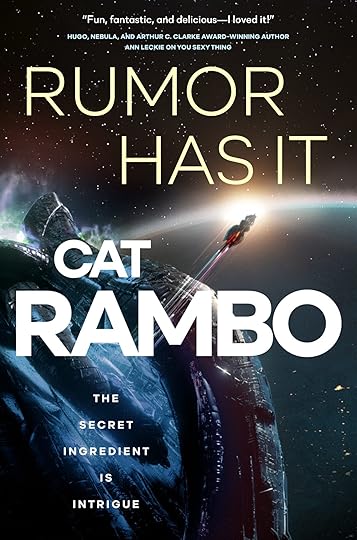
When I first started working on the Disco Space Opera series, I knew one thing that I really wanted to do over the course of it: have a long-simmering love triangle that would play out over the course of the series that would resolve in the final book, and by then (hopefully) have readers on the edge of their seats. By now, all three are apparent: Captain Niko Larsen, Petalia the Florian, and the enigmatic, roguish Jezli Farren.
One of the reasons I wanted to do that is I find it so satisfying when another author does it. When they create characters you care about, characters who you want to see find themselves and happiness. Characters who you don’t want to say goodbye to, so you find yourself slowing in that final chapter, reluctant to let the connection end. That’s one thing a satisfying ending does: gives the reader a chance to say goodbye while reassuring them that the character will have a happy ending of one sort or another.
One of my favorite series, one that I’ve read four or five times now, is Dorothy Dunnett’s The Lymond Chronicles. They’re not speculative (they’re historical fiction), but they’re masterclasses in handling description and dialogue, and in layering in clues and subtle foreshadowing. Even when I’m rereading, every time I hit the last few chapters, I’m slowing because I don’t want to leave that collision of perfect things that is the culmination of the romantic plotline in the final book.
If I create something a tenth as engaging as that, I’ll be happy. So my favorite bit about RUMOR HAS IT is a chance to advance some of the details of that plotline. Niko doesn’t know yet that she’s attracted to Jezli – or at least she hasn’t admitted it – but she does know that Jezli can get under her skin in a way no one else can.
At the same time, Niko still hopes for a reconciliation with Petalia, her long lost lover, who has been poisoned against Niko by a long-time enemy. Petalia seems to be warming in recent days, but Niko knows it could be part of a long-running trick, and has no idea whether she’ll ever be able to trust them.
Meanwhile Petalia seems to be stringing Niko along half the time, and rejecting her the rest.
It’s all a lot of fun, particularly Jezli, who is a con woman and persuader by trade. So I loved doing moments like this:
Petalia’s eyes narrowed. “It’s not Festival time there, is it?” they demanded. “That would be insane.”
This time, Niko’s eyes wandered, seeking Jezli’s. Her lips quirked. “WEll,” she said, and Jezli held her breath. “Certainly it would be, and certainly it is, but that is exactly what we are doing.”
“Just when I thought it was impossible to like you much better,” Jezli said. “You are a daring woman.”
“Desperate, perhaps, rather than daring,” Niko said, her tone softer than it had been.
Petalia glanced between the two, and their eyes filled with an emotion Niko had not seen in their pale depths for a long, long time.
I’m also enjoying watching Niko’s second in command, Dabry’s reaction to all of this. He knows Niko better than anyone, and he’s rooting for one of the participants in particular, while also savoring seeing his captain just a little taken at a loss for what to do. Other crew members have their own opinions of the matter, although several of them are, like You Sexy Thing, clueless about it all. Only Lassite and I, though, know what’s going to happen in the end.
Someone asked me recently how much of an outline I have for the overall series, and the answer is: not much of one. I know the steps the romantic plotline takes each time, and how it relates to what’s happening to the focus of each book, but other than that, I’m letting the books show me the way with only those barest of navigation aids. It’s so much more fun that way. I hope some of that relish adds to the flavor of the latest book.
LINKS:
BIO:
CAT RAMBO (they/them) is an American fantasy and science fiction writer whose work has appeared in, among others, Asimov’s, Weird Tales, Chiaroscuro, Talebones, and Strange Horizons. A graduate of the Johns Hopkins Writing Seminars, where they studied with John Barth and Steve Dixon, they also attended the Clarion West Writers’ Workshop. They are currently the managing editor of Fantasy Magazine. They published a collection of stories, Eyes Like Sky and Coal and Moonlight, and their collaboration with Jeff VanderMeer, The Surgeon’s Tale and Other Stories, appeared in 2007. They live and write in Washington State, and Cat Rambo is their real name.
October 1, 2024
My Favorite Bit: Kristy Gardner talks about THE STARS INSIDE US

Kristy Gardner is joining us today to talk about her novel, The Stars Inside Us. Here’s the publisher’s description:
She’ll burn it to the ground…
The ashes have settled since Calay’s harrowing escape back to Earth, but the threat from the Others-and humanity itself-hasn’t. After surviving devastating losses and impossible choices, Calay drags herself to the doorstep of the one place she never wanted to return: The Resistance.
Forced to trust hidden motives and questionable loyalties, Calay intimately knows the only way they survive, is together. But as she dives deeper into alien territory, her new reality is even more alarming than she could have anticipated. A perma-winter has settled over the planet. A strange new league of mutations has emerged amongst the Others. And despite her best efforts, past decisions come back to haunt Calay-taunt her.
It doesn’t take long for her plans to go horribly wrong. Her terror is compounded when she realizes she’s not only trapped with the enemy-a group that would gladly kill her if they knew her secrets-but that she’s actually started to care for them; especially Briar, the tea-loving, open-hearted woman who makes Calay feel like home.
In these final dying days, stars collide and the darkness within ignites. The world’s future is in Calay’s hands and she must decide what’s more important: saving herself, or saving what makes us human.
Hopeful and devastating, The Stars Inside Us is the third volume in Kristy Gardner’s enthralling queer sci-fi series, The Broken Stars.
What’s Kristy’s favorite bit?
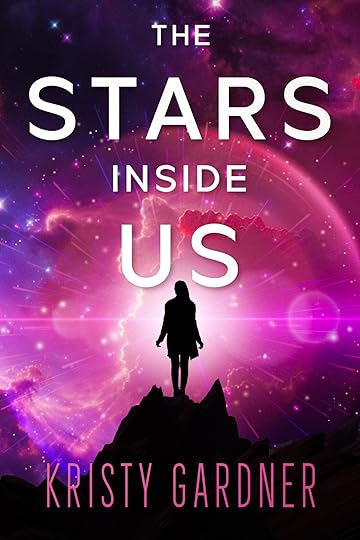
Despite the fact that I’m an introvert who prefers the peaceful (often elusive) solitude of my own company, my favourite bit of The Stars Inside Us is the cast of characters we meet at the end of the world, in this third and final chapter of Calay’s journey.
Shocking, I know.
When I first started writing The Broken Stars series, these books were born from unexpressed sadness and suppressed rage—written by a woman clawing her way out of self-abandonment and narcissistic abuse. They took root in that pain, but over time, with enough sunlight (and words), grew beyond it. And at the heart of that growth was queerness. This series is unapologetically queer—sapphic, with neurodivergent, bi, pan, and non-binary representation, and characters who are messy, flawed, and beautiful. Just like real life. But you know, with an alien apocalypse.
This third book feels different. In the first two, Calay spent much of her time isolated, grappling with her inner demons. There’s still plenty of that in The Stars Inside Us, but this time, she’s not fighting alone. A whole new community barged into her life with this book—and mine—and left a mark that changed everything.
I’d like to tell you a little bit about them.
Briar is the kind of woman who sneaks up on you, quietly powerful and deeply complex. In the book, Calay finds herself unexpectedly drawn to her—sapphic love at first sight. Briar’s got secrets, passion, and a bit of a ‘don’t mess with me’ attitude, but underneath all that? She’s got a big heart. Writing her was like peeling back layers of an onion, and every time I thought I knew her, she surprised me.
Adam–we met him in book 1. He’s not your typical “good guy,” but he’s not a bad guy either. He and Calay have this complicated, messy relationship—one minute they’re trying to save each other, the next they’re ready to tear each other apart. Trust me when I say Adam’s moral compass is as twisted as his past. But like a true survivor, he’s trying to make sense of the chaos around him, and sometimes, that means making impossible choices.
Speaking of chaos, I can’t wait for you to meet Salem. With her sharp edges and sharper wit, she’s one of those characters who just gets under your skin. She’s a survivor, like the rest of them, but her methods are… let’s just say unconventional. Calay learns that trusting Salem is like walking a tightrope—you never know if she’s going to pull you back to safety or cut the line.
Holden is one of my favourites. They’re a wildcard—chaotic energy wrapped in an intense, genius package. Holden’s the kind of person who thrives in the shadows, the one you’re not sure if you should trust or run from. But as Calay discovers, sometimes the darkest places are where you find the light.
Then there’s Callum. Loyal, steady Callum, the one you can count on when the world is falling apart. He’s not flashy; he’s not trying to be. But when it comes to protecting the people he cares about–like Adam, Callum is as fierce as they come. Writing him was about finding strength in quiet moments, in those tiny, almost invisible acts of bravery that make us who we are.
Ezra is a character who’s hard to forget. He’s also hard to like. He’s brilliant, violent, but also carries a deep sense of guilt that never quite leaves him. There’s weight in every decision, and that inner tension makes him one of the more complicated people in Calay’s orbit. Ezra’s been shaped by the losses he’s endured, but that grief fuels him in ways that catch everyone—including Calay—off guard. He’s the guy who seems to have it together on the surface, but underneath, there’s a storm brewing.
Of course, I can’t forget about Max–a reader fan-favorite. Max, the black pitty-mix with golden eyes and white paws, is more than just a furry companion—he’s a symbol of loyalty, hope, and the simple love that can exist even in the darkest times. In a world that’s falling apart, Max represents a pure, unbreakable bond. Calay’s relationship with him is one of the most heartfelt parts of the book, a reminder that sometimes, the smallest acts of love are the most powerful.
But here’s the thing: wrapping up this story was bittersweet. One of the hardest parts about writing The Stars Inside Us was saying goodbye to these characters. They’ve been with me for a short amount of a time–for a reason. A season. And maybe in my imagination, a lifetime.
As for Calay, this book is the ending she deserves. She finally finds her voice, her true power within. She’s been through hell, across the stars and back, and in these final dying days, when the world is in her hands, she must decide: save herself, or save what makes us human. Watching her come into her own and embrace who she is, flaws and all—that’s been the most rewarding part of this entire journey.
I’m forever grateful to everyone who’s stuck with me (and Calay) through this wild ride. Thanks for coming. Nine years later, here we are. The end is neigh, and I couldn’t have done it without a single one of you, or these characters. Now, let’s light ‘em up.
LINKS:
BIO:
Kristy Gardner (she/her) is a bi sci-fi, fantasy, and horror writer. She is the author of the Broken Stars sci-fi series, and the award-winning cookbook, Cooking With Cocktails. Furnished with degrees in Gender Studies and Sociology, she crafts queer characters that adventure through space, time, and emotional maelstroms questioning what identity – and home – really mean. When she’s not jet-setting words on her laptop, she’s chasing stars, mountain adventures, belly laughs, curating playlists for her books, and packing her carry-on for another escape to SE Asia. She resides in Vancouver B.C. with her partner. Sign up for her monthly newsletter to get the playlists for each book at https://kristygardner.com/newsletter
September 17, 2024
My Favorite Bit: Heather Tracy talks about FIERY DEEPS

Heather Tracy is joining us today to talk about the anthology she edited (and wrote in), Fiery Deeps. Here’s the publisher’s description:
“Fire is Power!
Quest to the heart of the earth, cross flaming rivers, and brave the fire with our heroes to discover unlimited strength! From fantastic underground cities, to superheroes, to magic of the forge, titanic forces of nature collide in this lesbian-centric anthology focusing on the power of women.
Contains stories by: William C. Tracy, J.S. Fields, Robin C.M. Duncan, Sara Codair, N.L. Bates, Rosiee Thor, Maya Gittelman, Heather Tracy, N. Romaine White, and Dee Lyle!”
What’s Heather’s favorite bit?
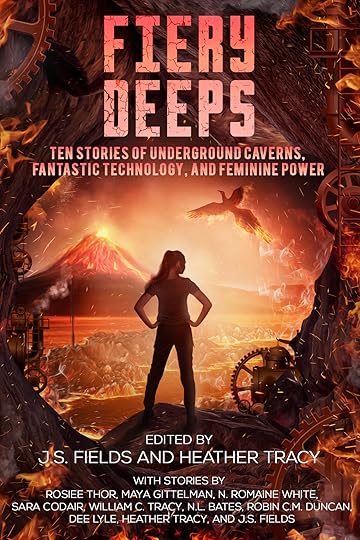
I could beat around the bush here and talk about several parts of my story, “Flame Retardant,” that I love, but let’s be serious. My favorite bit about my story is getting to set fire to a certain fabric store.
You know the one. You’ve shopped there. You’ve gotten caught behind the people who can’t figure out how to find their coupons in the app or stood in line at the cutting counter for way too long just to get one yard of fabric while someone else was getting one yard of every fabric in the store. In my story, I renamed it Judy’s Fabrics—both to protect myself and to pay homage to my Aunt Judy. But, having several friends who have worked at said fabric store over the years, and having had my own trials and tribulations shopping there—Spoiler Alert—I was all too happy to have it meet a fiery end.
The main idea for my story came from a Twitter thread from May of 2020 that made the rounds on various social media channels, as all the great ones do. It was from @katiehahnbooks and proposed a “romcom about a lesbian seamstress and the [fabric store] employee who falls a little bit more in love every time she asks the corporate-mandated ‘so what are you making with this?’ question and the seamstress goes on a passionate rant about her project it’s called girlfriend material.” I loved the idea and knew I wanted to write a story for this prompt one day. And, the fact that my husband runs a queer science fiction/fantasy publishing company doesn’t hurt either.
Fast forward to 2023 when we went on a trip to Greece, and I was inspired by all the ancient architecture depicting gods and goddesses with various powers. I knew the last of our Worlds Apart anthologies was going to be focused on fire and female power, so I thought about what it would be like if superheroes were all around us and were descended from Greek gods/goddesses? And, what if my heroine inherited her fire powers from Hestia, Goddess of the Hearth, but she was still getting used to said powers? Further still, what if she needed to make a superhero suit and had to go into a certain fabric store to buy her material, and oops, just happened to meet the cutest girl in the world?
So, this story is partially inspired by a viral Twitter thread, partially by my love for travel and history, and partially to get metaphorical retribution for my friends who suffered while working in a fabric store. Plus, who doesn’t love a good lesbian superhero story? And, if all that wasn’t enough, our fabulous illustrator, Katie Cordy, has designed a brilliant piece of art for my story so you can see the fires burn in Jo…err…Judy’s Fabrics.
LINKS:
BIO:
Heather Tracy (she/her) is a travel agent by day, and a masked copy editor and writer by night. As a travel agent, she plans Nerdventures—travel for the nerd in all of us. These can be anything from visiting New Zealand to see as many Lord of the Rings filming locations as you can to visiting castles in Europe to following in the footsteps of your favorite author.
As a copy editor, she’s found hundreds of typos, comma splices, and other grammatical nitpicks for Space Wizard Science Fantasy since before 2016. With over 30 titles copyedited, this year she turns her hand to her first published short story in Fiery Deeps, and her first novel, Only a Chapter, which features some of her personal journey surviving breast cancer.
Heather lives in Raleigh with her husband of over twenty years, William C. Tracy, where they have two rambunctious cats and several beehives. They enjoy taking their own Nerdventures—as much as they can be away from their small businesses—and cosplaying at various markets and cons throughout the year.
September 12, 2024
My Favorite Bit: Carmen Loup talks about THE AUDACITY

Carmen Loup is joining us today to talk about their omnibus, The Audacity. Here’s the publisher’s description:
May’s humdrum life is flung into hyperdrive when she’s rescued from an alien abduction by Xan, an alien with a fondness for ‘I Love Lucy’ who lives on The Audacity. But when Chaos incarnate decides to turn Earth into her personal sandbox, the Audacity and May’s new-found love of rocket racing are the only things that can stop her.
But even being wildly successful rocket racers isn’t enough for May and Xan when a tea-sipping robot arrests Xan, and Chaos steals the Sphere of Time. May must team up with Xan’s sister, Aimz (an adventure biologist) and her undead girlfriend to save Xan, the Audacity, and Time Itself.
Stranded without the Audacity on a tiny, frigid island, Xan and Aimz succumb to the Carmnian Scourge. As a last act, May must team up with old friends, enemies, and a haunted Big Mouth Billy Bass to find a cure before the goddess of Chaos enacts the final stage of her universe befuddling plan.
What’s Carmen’s favorite bit?
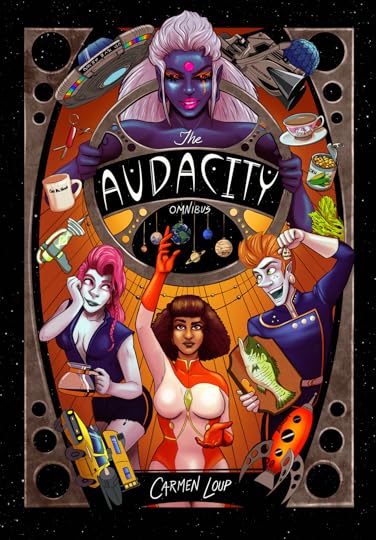
There’s a scene in The Audacity book 2 which combines several of my favorite tropes into one go. The setting is an abandoned underground alien theme park; the antagonist is an enormous, blind many-toothed sand-worm-thing; their only assets are a rust-bucket of an AMC Gremlin and an impossibly dull pocket knife; and there’s lots of slimy acidic goo involved to dissolve our main character’s clothes. What could be better?
The dialogue in that scene hints at May’s past, which she’s usually very tight-lipped about, and Xan’s excitement at getting a little hint of Deep May Lore is a lot of fun. He’s going through some dark stuff in that book, so he jumps at the chance to put the spotlight on her backstory for awhile.
Also, by the end of it, their clothing has dissolved and Xan is reduced to covering up with a tiny novelty flag that says “I Had Fun in the Pontoosa Adventure Hole” which always makes me chuckle. It becomes an inside joke between them, one of many.
LINKS:
BIO:
Carmen Loup is a humorologist, illustrator of “Tarot in Space”, and creator of “The Audacity” sci-fi novel and comic book series. Loup is inspired by Douglas Adams, Ram Das, and Alan Watts to create psychedelic speculative fiction with a hopeful spin that shines through even ridiculously horrible situations.
September 10, 2024
My Favorite Bit: Ursula Whitcher talks about NORTH CONTINENT RIBBON

Ursula Whitcher is joining us today to talk about their novel, North Continent Ribbon. Here’s the publisher’s description:
On Nakharat, every contract is a ribbon and every ribbon is a secret, braided tight and tucked behind a veil. Artificial intelligence threatens the tightly-woven network. Stability depends on giving each machine a human conscience–but the humans are not volunteers. In the midst of strife, individual people struggle to hold onto their jobs and protect their lovers, those trusted few who could draw back the veil.
Part of the Neon Hemlock Novella Series.
What’s Ursula’s favorite bit?
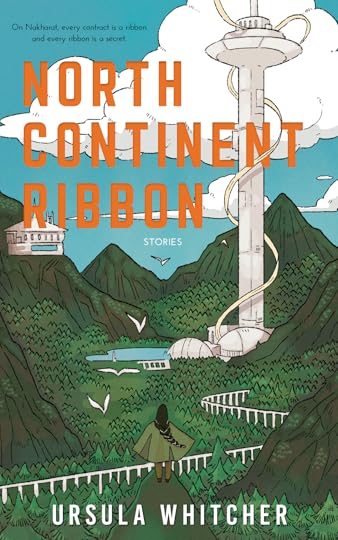
My favorite part of North Continent Ribbon is the beginning of a crime: a hasty courthouse wedding.
I needed a crime because North Continent Ribbon is a book about convict labor. On the planet of Nakharat, every train, ship, or space elevator car—every big, fast-moving vehicle that could kill you—has an embedded human conscience. Each of those trapped humans is a criminal.
I built North Continent Ribbon like a mosaic, with each of its short stories saying something different about who the Nakhorians are and why they fear machine intelligence. I knew the final story had to stare injustice straight in the face. My protagonist, Aizuret, would be condemned to become the conscience of a spaceship—and figure out how to unionize the other ships.
At this point in my planning, I ran into a problem. I wanted Aizu to make a very relatable bad decision. But in many ways, Nakhorian society is better than our own. They have widespread carbon-neutral public transit! Hungry people can visit any city cafeteria! And unlike the United States that I grew up in, Nakharat never had a War on Drugs.
For inspiration, I turned to history. Some years ago, in one of the weirder intellectual tangents I pursued before realizing I was simply very queer, I read through a huge stack of eighteenth-century sexuality records in the proceedings of London’s Old Bailey. There were depressing accounts of servants and roommates spying on (alleged) sodomy. There were also a startling number of bigamy cases: when divorce was difficult, people simply moved one town over and married someone else.
I’d established that Nakhorians took oaths and vows extremely seriously. Bigamy would definitely be a crime. Aizu could get depressed, move one continent over, and try to begin again. But I had one problem left to solve: I had already established that, in a grand space-opera tradition, Nakharat allowed for fixed-term marriages. I had to create a character who wouldn’t hedge her bets.
Here’s what happens when the judge asks Aizu and her fiancée how long their marriage will last:
Rayet and I exchanged glances. Rayet seemed unusually tentative. She was offering me a last chance to regret. But I didn’t want to. I didn’t want her to think she was an impulse or a bad holiday decision. That would have been insulting. A year and a day seemed almost as bad.
I could have said four years, or eight, or a dozen years and months and days. But I was young, so young that at every step I felt I could bounce away from the planet, weightless, and a dozen years felt like a less complimentary version of forever. I couldn’t imagine forever with Rayet. But I wanted to. I said, “A permanent contract.”
Rayet tucked her chin in the tiny nod that meant, “I am winning this round,” and also, “Yes.”
I love this feeling. Aizu is falling towards her doom, but in a way that feels like flying.
Aizu won’t actually commit her crime until she meets someone different—a kind woman, someone who likes babies and dogs and the cheerful, thankless work of neighborhood political organizing—and tries to marry again. But she and I agree that the exhilarating, delicious part of her terrible decision is right here, at the beginning, with Rayet.
LINKS:
BIO:
Ursula Whitcher is a queer writer, poet, and mathematician who lives in
Ann Arbor, Michigan. When not doing down-to-earth things like drinking
black coffee, naming cats after medieval saints, or writing about
unionized spaceships, Ursula tries to use the physics of string theory
as a glorified calculator.



